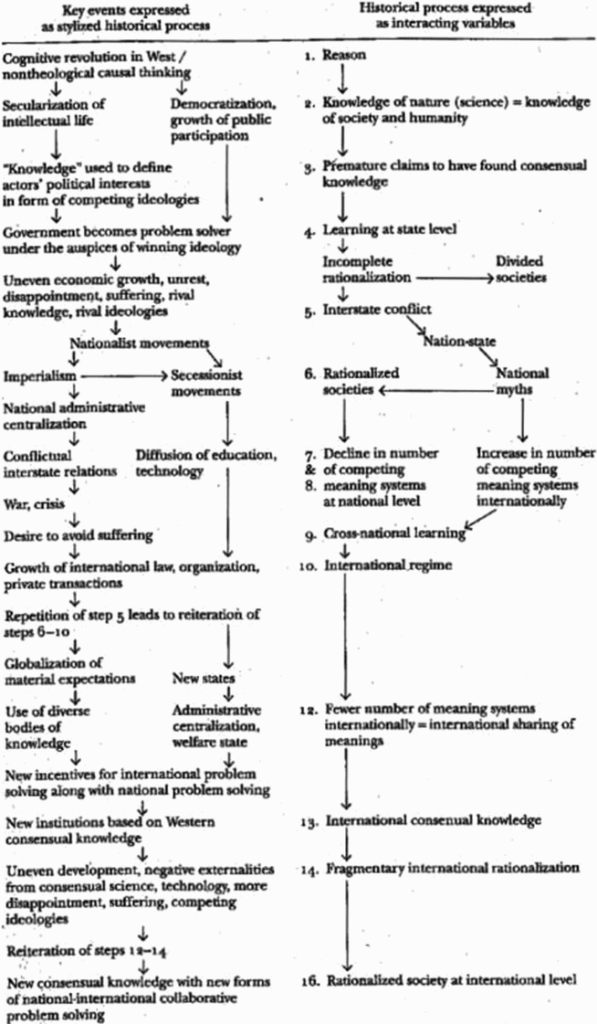Ernst B. Haas made a major contribution to the study of international relations. Peter M. Haas reflects on his life and examines how his work can help us to better understand contemporary politics.
Ernst B. Haas is a seminal figure in the study of international relations whose work helps guide our understanding of 21st century politics. In 1997, Foreign Affairs deemed The Uniting of Europe as one of the fifty most significant books in international relations in the 20th century. He was instrumental in developing many of the themes commonly used to understand world politics: regional integration, international regimes, science and institutions, nationalism and international relations theory. As his only son, in this blog is a deeply personal reflection on his life and work.
Life and work
He was born on 31 March 1924 and died on 6 March 2003, from a stroke at the too-early age of seventy-nine. His formative experience was in 1930s Germany. While he rejected an overly psychological explanation of his influences, he did recognise that growing up in a fascist and antisemitic environment profoundly shaped his lifelong suspicion of most institutions (the state, German society and the military), as well as his profound commitment to the prospect of the Enlightenment and progress through reason, deliberation and consensus formation. He believed that the modern university at its best could be a guardrail against institutional and public excesses.
He was born in Frankfurt to assimilated German Jewish parents, both sides able to date their ancestries back to the eighteenth-century Frankfurt-am-Main region. His father Siegfried (Fritz) Haas had a PhD from Heidelberg University and was a museum curator at the Senckenberg Museum in Frankfurt, specialising in freshwater malacology (snails), and his mother Helene Ganz Haas managed the household. He had one sister, Edith Haas Cornfield, who was a Juilliard educated concert pianist and music educator.
He was bar mitzvahed by choice, so he could find out what being Jewish meant since he was being tormented daily for being Jewish by young brown shirt thugs on his way to school. The family emigrated to Chicago in July 1938, mere months before Kristallnacht, when his father finally found a job at the Field Museum in Chicago. He spent one year at the University of Chicago and then enlisted in the US army at once after the Pearl Harbor bombing. He spent his wartime in Ann Arbor learning Japanese and Japanese culture, playing chess instead of physical education.
In 1945 he and my mother Hildegarde Vogel married. A professional painter, she was also a native Frankfurter whose family had emigrated to the US in 1937. They remained happily married until her death in 2002, five months before him. He quit the army immediately after the war to complete his BA and to pursue a PhD in political science, both at Columbia University. His 1952 dissertation, which he never published, was on Belgian independence.
He was proud that the thesis was well received by an interdisciplinary committee – as was the protocol at Columbia at the time – of lawyers, political scientists, and historians, each of whom said it could be published in their disciplinary journals. He first had a brief fill-in position at the University of Chicago, and then received an offer from UC Berkeley in 1951 to teach courses on the United Nations and international organisations. He spent his entire career at Berkeley, rising from Assistant Professor to an endowed chair. He was a fellow of the American Academy of Arts and Sciences and received major research grants from the Rockefeller Foundation and the Social Science Research Council.
A theory of progress
His lifelong concern was the foundations for human betterment and progress. Nationalism was a scourge of world politics, and he looked for a variety of ways in which it could be tempered. He focused more on agency than structure, and processes than outcomes, although in true Weberian fashion, processes were associated probabilistically with discrete outcomes. Normatively he focused on what he regarded as progressive outcomes: human betterment, economic development and the peaceful resolution of conflict. His notion of policy progress consisted of replacing hard problems with politically more tractable problems.
Underlying all his disparate work was a theory of progress. He fleshed out the model in 1997 and 2000 with empirical cases about nationalism in his two-volume magisterial project Nationalism, Liberalism and Progress – hardly a modest title, but it does give away the entire project. He thought and hoped that progress could occur. But it only happened occasionally and was subject to reversals.
He introduced a model of the evolution of rationalisation, cleverly presented as a stylised historical process and as a more analytically accessible historical process expressed as interacting variables at multiple scales.
Figure: Model of the evolution of rationalisation
Source: Ernst B. Haas, Nationalism, Liberalism and Progress (2000)
For him, world politics is shaped by a helix of technology, shared understandings by practitioners and common knowledge by international relations theorists. Technology provides the opportunity structure for politics and is subject to change over time from shifts in understanding and national material capabilities. The core of the helix is understanding, which itself changes through learning. International organisations and institutions remained intervening variables for him.
His model was fairly simple:
- Practitioners should expand the network of actors, including corporate and scientists. Analysts should also pay attention to the roles played by multiple actors. He was always a bit ambivalent about non-governmental organisations (NGOs) because of their lack of accountability.
- Keep the process moving: stasis is death.
- Practitioners should choose cases carefully for spillover. They should avoid human rights, as the issue is too contested.
- Practitioners should apply multiple spillover mechanisms, in particular persuasion and changing corporate interests.
- Practitioners should avoid and side-line spoilers.
- Be modest, the process is potentially reversible, and there is no teleology.
His students also carried on his message. John Ruggie was influential in international relations and Phil Schmitter was important for comparative politics. Emanuel Adler elaborated Ernie’s ideas about expertise to epistemic communities and later to communities of practice.
His work, and the work of his students contribute to a better understanding of the EU, global governance, environmental policy, nationalism and learning. He provided a roadmap for governing most global issues based on halting collaborative efforts by a diverse array of actors and academics who learn to develop new understandings of their world through interactions, and act on them. While progress occurs only occasionally, it occurs more often than most other theorists of international relations expect.
For more information, see the author’s accompanying paper in the Journal of European Public Policy
Note: This article gives the views of the author, not the position of EUROPP – European Politics and Policy or the London School of Economics. Featured image credit: AVN Photo Lab / Shutterstock.com





